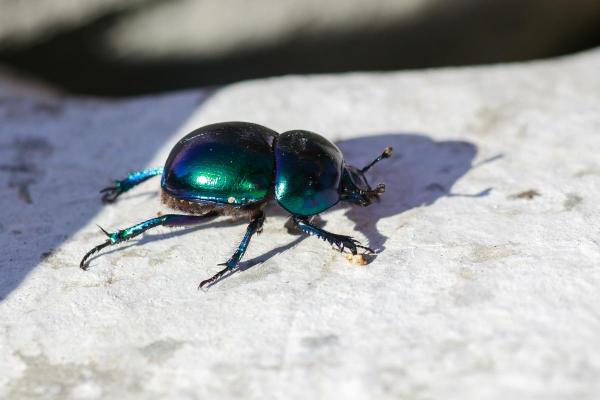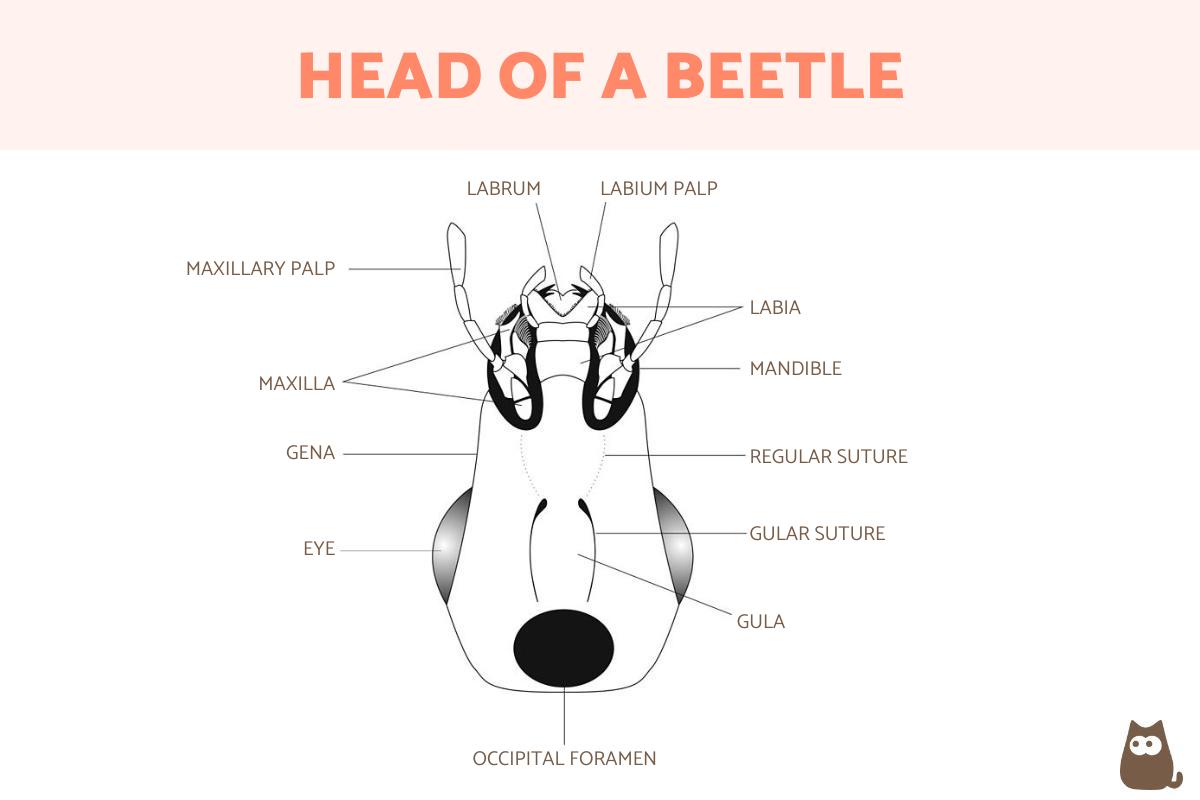Beetle Anatomy - Body Parts of Beetles


We can use a beetle's anatomy to distinguish them from other insects. Of the order Coleoptera, there are approximately 400,000 recognized beetle species, with more yet to be discovered. Since they are insects, there are certain anatomical similarities which are shared by all of these invertebrates. An example is the fact that beetles have six legs. It is anatomy that also help us to distinguish beetles as being different from other insects. From their elytra to their antennae, all the body parts of beetles reveal important information about their life, habitats and roles in their ecosystems.
To learn about beetle anatomy, AnimalWised explains the body parts of beetles. We provide information and diagrams on their characteristics and functions, showing what makes a beetle a beetle.
Beetle head
The first beetle body part we examine in close detail is the head. This is a vital part of their anatomy which allows them to carry out basic functions such as feeding. A beetle's head is made up from various individual parts, including the following (see diagram below):
- Cephalic capsule: the head of the beetle is covered by a tough structure known as the cephalic capsule. This capsule protects internal organs and provides structural support.
- Mandibles: located at the front of the head, the mandibles are strong, cutting appendages that allow the beetle to chew its food. The shape of the jaws can vary depending on the species, reflecting specific adaptations to the types of foods consumed.
- Clypeus: a frontal plate that covers the top of the head and is located between the antennae and the mandibles. The clypeus can vary in shape and size between species. It often plays a role in protecting the antennae and other parts of the head.
- Labrum: located below the clypeus, the labrum is a flat structure that forms the bottom of the mouth. It helps protect and support the jaws. It can sometimes be involved in handling or manipulating food before it enters the mouth.
- Antennae: beetles have segmented antennae on the top of their head. These antennae are highly specialized sensory organs that allow them to detect smells, tastes and vibrations in the environment. The length and shape of the antennae are also distinctive characteristics that vary between species.
- Compound eyes: most beetles have compound eyes, made up of numerous visual units called ommatidia. These eyes provide them with a panoramic view of the environment, something crucial for detecting potential predators, mating partners and food sources.
- Simple eyes (ocelli): some types of beetles also have ocelli, which are simple eyes located on the top of the head. These organs are involved in detecting light changes and contribute to the beetle's orientation in its environment. Not all beetles have these body parts.
- Cephalic formula: the cephalic formula refers to the anatomical arrangement and number of the different parts of the beetle's head. This formula can vary between species and is used as an important taxonomic trait to classify and differentiate beetle species.
Diversity in beetle head structure reflects their evolutionary adaptations to a variety of ecological niches (position in a given ecosystem) and survival strategies. From specialized jaws to highly sensitive antennae, each beetle anatomy feature triggers a fascinating evolutionary story behind these insects.
Discover which beetles are considered some of the largest insects in the world with our related guide.

Beetle thorax
The thorax of a beetle is a critical anatomical region that houses the legs and wings, although the latter does not apply to all beetle species. For beetles that do have wings, the thorax is important for flight. For all beetles, the legs are vital for locomotion.
The main parts of a beetle's thorax are as follows:
- Prothorax: is the first segment of the thorax, located closest to the head. The prothorax bears the beetle's first pair of legs. Some beetles have specialized anatomy known as ‘antennal clubs’ which appear as horns and are located on the thorax. This is the case of the dung beetle. Others have a scutellum on the thorax, an often triangular structure that covers the base of the wings when they are at rest.
- Mesothorax: the second segment of the thorax with the second pair of legs. The front wings in winged beetles are found in the mesothorax. These wings are protected by the elytra. This is a thick and hard protective covering over the membranous wings of winged beetles. The elytra protects the wings during rest and are raised to allow flight. Flightless beetles also have an elytra which protects the body.
- Metathorax: the third segment of the thorax carries the third pair of legs. In some beetles, especially flying ones, the metathorax is the site of insertion of the hind wings. These wings are called membranous wings or hind wings. They are the wings are used for flight.
Each segment of the thorax also contains muscles and internal structures that allow for movement and flexibility. Such movement is necessary for locomotor activity. The presence or absence of wings depends on the species. So too does the specific shape and function of the legs. Diversity in beetle thorax morphology reflects evolutionary adaptations that have allowed them to colonize a wide range of habitats and perform a variety of ecological roles.

Beetle abdomen
The beetle's abdomen is the posterior region of the body and consists of 10 to 11 segments. Although the abdomen does not have legs or wings, it plays a crucial role in vital functions such as digestion, reproduction and excretion.
We come to the final beetle body parts, so let's see what the abdomen in beetle anatomy is like:
- Tergites and sternites: each segment of the abdomen has a dorsal tergite and a ventral sternite. These are plates that line the outside and inside of the abdomen, respectively. They provide structural support and protection to internal organs.
- Internal organs: the abdomen houses a variety of internal organs, such as the digestive organs, reproductive organs and excretory organs. These include the digestive tract, the ovaries or testes, the Malpighian tubules (excretory organs), and other specialized organs which can vary depending on the species.
- Reproductive system: the reproductive organs of beetles are also located in the abdomen and vary between males and females. In males, there are testicles and often accessory organs for sperm transfer. In females, there are ovaries and sometimes specialized structures for oviposition.
- Genitals: the genitals, present at the posterior end of the abdomen, are responsible for copulation and oviposition. The morphology of the genitalia may be a distinctive feature used in beetle species identification.
- Pygidium: in some beetle species, the last segment of the abdomen may have a special structure called a pygidium. This structure can vary in form and function. In some cases, may play a role in the beetle's defense.
The anatomy of the abdomen of beetles can vary significantly between species. The adaptation of these structures to different environments and ways of life is evident in the diversity of forms and functions observed in this group of insects.
You can learn about certain types of beetles and their specific diet with our article on insects that eat wood.
If you want to read similar articles to Beetle Anatomy - Body Parts of Beetles, we recommend you visit our Facts about the animal kingdom category.
- Bar, M.E. (2010). Order Coleoptera. Biology of Arthropods, 1.
- Barnes, R., & Ruppert, E. (1997). Invertebrate Zoology. 1714 p.
- Beutel, R. G., Lawrence, J. F., & Leschen, R. A. B. (2005). Coleoptera, morphology.
- Crowson, R. A. (2013). The biology of the Coleoptera. Academic press.
- Ruppert, E. E., Fox, R. S., & Barnes, R. D. (2005). Zoology of invertebrates: a functional-evolutionary approach. Zoologia dos invertebrates: a functional-evolutionary approach (pp. 1045-1045).
- Zarazaga, M. A. (2015). Insect class Order Coleoptera. Rev. IDE-SEA, 56, 1-18.







